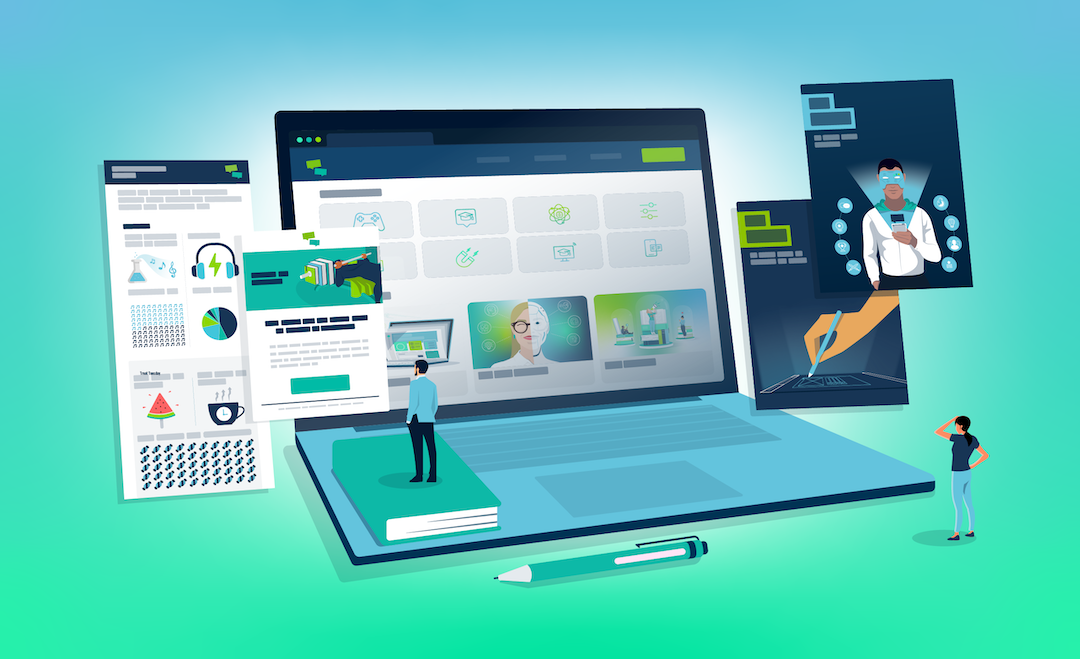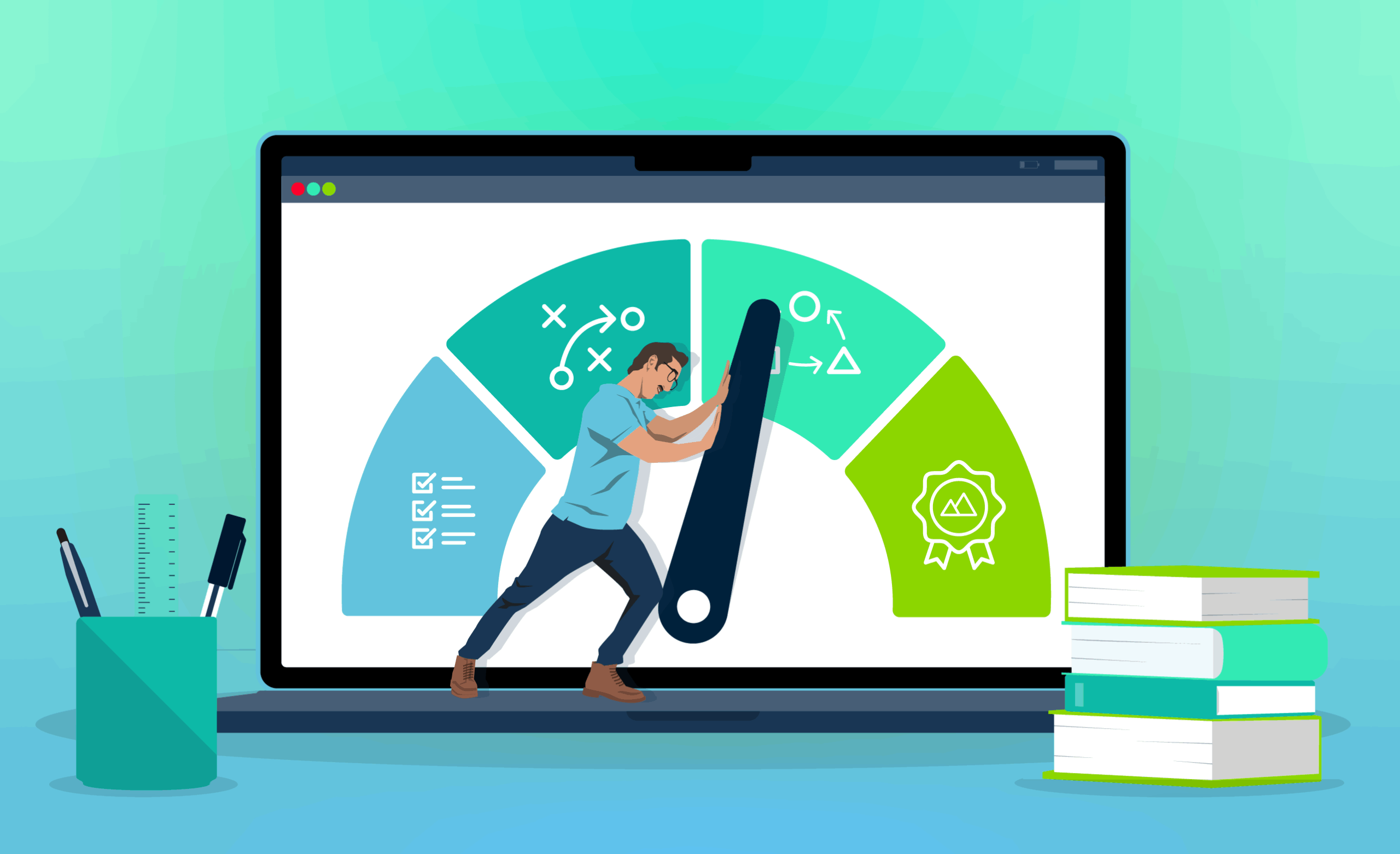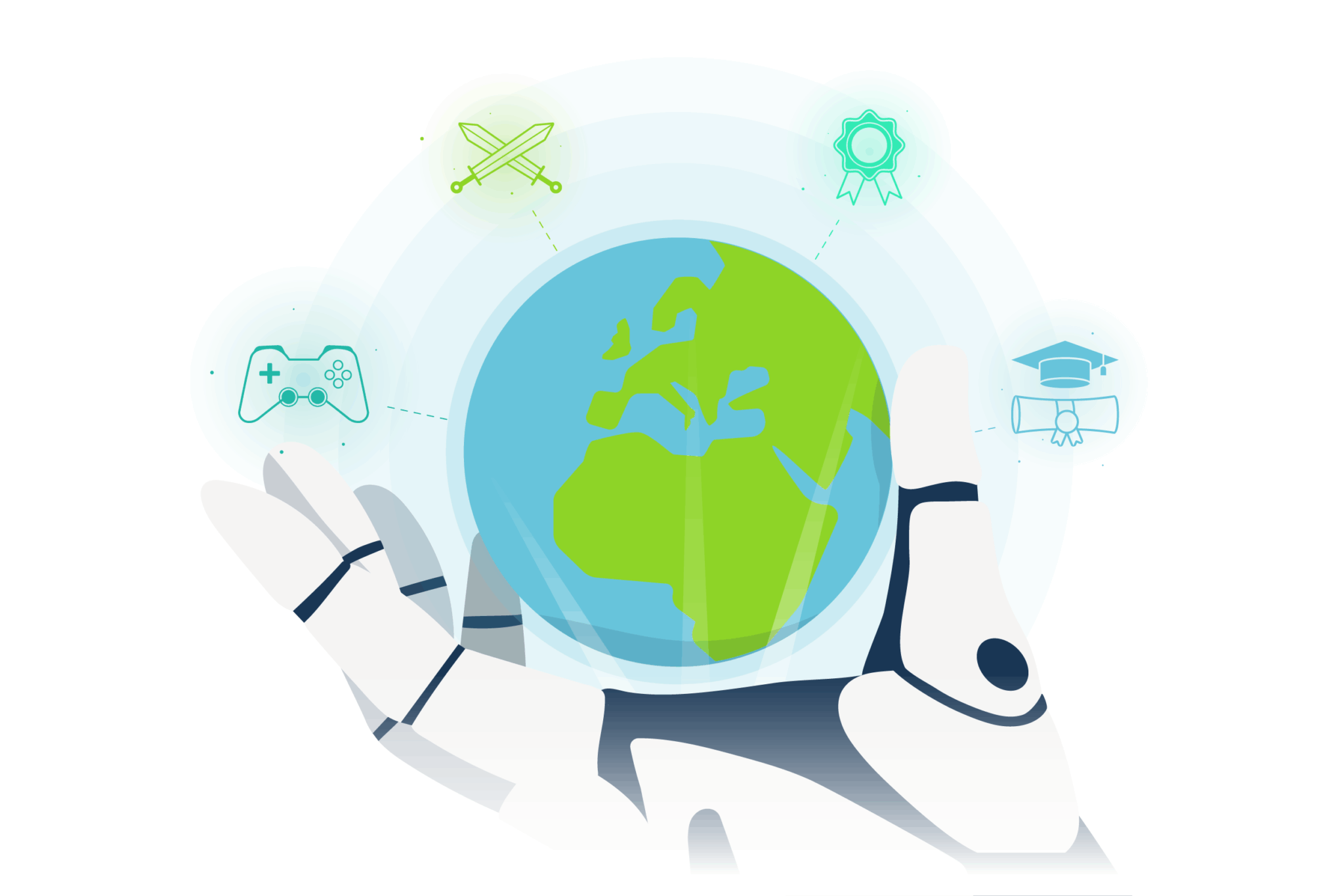
Artificial intelligence (AI) is no longer a futuristic concept. It’s now a present-day force that’s maturing at wig-spinning speeds. Along the way, it also happens to be reshaping the world of learning and development (L&D).
Its transformative power is why it tops our list of the biggest L&D trends for 2025.
This shift prompts some important questions: If the potential of AI is so great, how do we leverage it effectively? Will it empower or replace learning professionals? And how do we address the ethical challenges associated with this new technology?
In the words of former Google CEO Eric Schmidt, ‘the greatest breakthroughs wont come from AI alone, but from those who learn to harness it’.
This article will equip you to do just that. We’ll explore artificial intelligence’s applications, benefits, and challenges in L&D. We’ll even provide you with some actionable steps to get you up and running. But first, let’s start by setting the scene.
The AI Revolution
Artificial intelligence has burst out of our sci-fi fantasies (like an Alien facehugger!) and is now a vibrant part of our reality. Today, we can use AI to communicate with dolphins, call our parents for us, and dollify ourselves. It can even fire us. Wonders abound!
Beyond the novelty, artificial intelligence offers numerous practical applications. AI tools can perform skin cancer checks, aid blind people in navigation, and, as we’ll explore, meaningfully shape how we develop and nurture talent.
This year (2025), the artificial intelligence market is projected to reach $244.22 billion. From there, it’s expected to grow at a CAGR of 26.6% until 2031, when it will be worth an eye-watering $1 trillion. McKinsey puts the long-term AI opportunity value at closer to $4.4 trillion.
The United States will hold the largest market share, but don’t count out other regions. For instance, China has made some serious inroads thanks to tools like DeepSeek. But what about the impact on businesses? Well, the numbers speak for themselves.
- Nearly half (49%) of tech leaders say that AI is now ‘fully integrated’ into their companies’ core business strategies.
- Research suggests that 78% of organisations are now using AI in at least one business function.
- And 83% of business leaders agree that AI adoption would accelerate if they had a better data infrastructure in place.
Artificial intelligence is clearly here to stay. Now we just need to ensure that we make the most of it.
Understanding Artificial Intelligence
Before we dive in and navigate the world of AI in learning and development (L&D), it’s helpful to have a clear understanding of all the key terms. So, let’s break down the essential concepts you’ll encounter, starting with the different definitions of AI.
- Artificial Intelligence (AI): Put simply, artificial intelligence, or AI, is the broad field of science and engineering dedicated to creating machines and computer programmes that can complete tasks that usually require human intelligence. Typically, machine learning and deep learning achieve this (more on this below).
- Weak AI (or Narrow AI): This refers to AI systems that nail one particular task. They often become experts in that particular area, and can even surpass human skill, but their abilities stop there. You can see this with Deep Blue, crushing it at chess, or AlphaGo, dominating at Go. Both are brilliant within specific limits.
- Strong AI (or General Intelligence): In contrast to AI focused on specific tasks, strong AI envisions machines with human-level smarts across many areas. They’d understand, learn, and apply themselves, just as we do. Picture a robot who could both ace a university exam and have a meaningful conversation.
- Super Intelligence: This type of intelligence is yet another step beyond: it’s AI that could outsmart even the brightest humans in every possible way — and by a huge margin. According to OpenAI’s Sam Altman, this sort of intelligence is a ‘few thousand days’ away. Yikes.
- Generative AI (or GenAI): Finally, we have AI models that are built to produce new and original content by learning from existing data. Right now, popular examples include large language models (LLMs, explained below) that can hold full conversations and generate text, images, audio, and video.
Demystifying Key AI Concepts
That’s a good start, but we’ve got more ground to cover. Navigating the AI landscape can feel like learning a whole new language. With this in mind, here are some further definitions of the most important concepts you’ll encounter.
- Machine Learning: This refers to a subset of AI that enables computers to learn from data, thereby bypassing direct commands or explicit programming. Instead, algorithms (see below) are used to identify patterns in training data, which then inform predictions, and shape decision-making as the system evolves.
- Deep Learning: A more advanced subfield of machine learning that uses artificial neural networks (inspired by the human brain) with multiple layers (hence the ‘deep’). These networks can automatically learn to recognise complex features and patterns in huge amounts of data, which has helped to turbocharge AI’s major breakthroughs.
- Algorithms: In this context, algorithms are sets of instructions or rules that a computer follows to solve a problem or perform a specific task. They tell AI systems how to process data, learn patterns, and make decisions. For example, a recommendation algorithm might suggest training content based on what you and similar learners have liked (alongside other criteria).
- Natural Language Processing: This branch of AI focuses on enabling computers to understand, interpret, manipulate, and generate human language (both written and spoken). It achieves this by breaking down text into smaller pieces (tokens) and applying machine learning. This is the engine behind chatbots, translation tools, and sentiment analysis.
- Large Language Models (LLMs): An LLM is a deep learning model with millions of parameters trained on mountains of text data (hence ‘large’). This scale helps them to understand and generate human-like text for a wide range of tasks. As a result, they can help with writing, translation, summarisation, and so on. Familiar LLM examples include ChatGPT, Claude, and Gemini.
Artificial Intelligence: A Timeline
The loud buzz around AI in L&D stems from decades of fascinating progress. This timeline offers a snapshot of the key breakthroughs that have paved the way for the intelligent tools that are gaining prominence today.
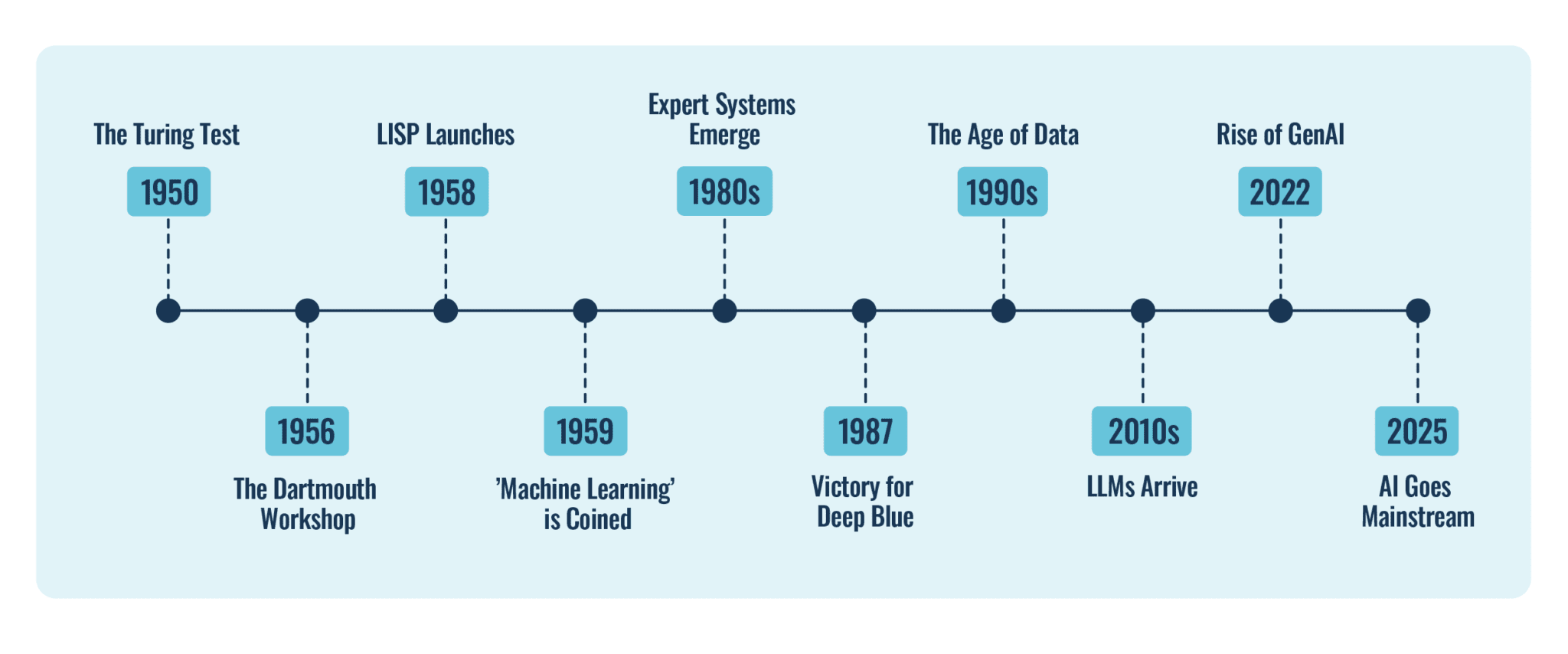
- 1950 — The Turing Test: Alan Turing makes the first real attempt to define and measure machine intelligence, sparking decades of research and debate.
- 1956 — The Dartmouth Workshop: This event brought together key researchers and set the agenda for early AI exploration. Consider it the birth of AI as we know it.
- 1958 — LISP Launches: John McCarthy rolls out LISP, a programming language that would provide a crucial toolset for early AI development.
- 1959 — ’Machine Learning’ is Coined: Arthur Samuel coins the term ‘machine learning’, marking a shift towards algorithms that learn from data.
- 1980s — Expert Systems Emerge: The 80s see some commercial success for early AI applications, although these solutions had their limitations.
- 1997 — Victory for Deep Blue: IBM’s Deep Blue beats chess legend Garry Kasparov, creating a watershed moment for AI and demonstrating its growing power.
- 1990s — The Age of Data: The 90s see the rise of search engines like Google, leading to an explosion of data that would later propel machine learning techniques.
- 2010s — LLMs Arrive: Towards the end of the 2010s, breakthroughs in natural language processing lead to the creation of highly capable models like GPT.
- 2022 — Rise of GenAI: New AI models emerge that are capable of creating sophisticated and novel content (including text, images, audio, and so on).
- 2025 — AI Goes Mainstream: AI is increasingly woven into the fabric of both learning and development and our everyday work lives.
Practical Applications of AI in L&D
Now that we’ve got the artificial intelligence basics covered, we’re ready to get into the nitty gritty. As an L&D pro, you’re likely asking: ‘what does this mean for me?’ Well, you’re not alone. Indeed, 4 in 5 learning professionals want to learn more about how to use AI to support their work.
As it happens, ‘enhancing learning’ is the fourth biggest use case for GenAI (with ‘companionship’ at number one). This is critical in L&D, where a concerning 25% of employees feel their training has no impact. Let’s explore how AI can help you reverse this trend.
1. Personalised Pathways

No two learners are the same, so it’s painful to expect everyone to trudge through the same training experience. Thankfully, AI enables personalised learning at scale, by getting to know everyone’s current abilities, needs, and learning preferences.
For instance, consider Kelly, a new marketing hire. Your learning platform’s AI spots that she’s a social media wiz, but has knowledge gaps when it comes to SEO. Consequently, instead of making her review social media basics, it prioritises the SEO materials she needs most.
The result is a dynamic and tailored learning experience that significantly increases content relevance. Evidence backs this up: a metareview of 69 studies found that personalised and adaptive learning improved academic outcomes in 59% of cases.
2. Content Creation

GenAI is the ultimate brainstorming buddy and content creation tool. While we don’t recommend using these solutions to create full training units or materials, they can definitely support you in generating ideas, outlining topics, and creating first drafts.
Here’s some practical suggestions to get you started:
- Quickly draft learning objectives.
- Instantly generate a glossary of key terms.
- Effortlessly create quiz and assessment questions.
- Rapidly develop engaging learning scenarios.
- Create a first draft of learning content.
- Easily translate your learning materials.
- And generate visuals and assets for eLearning units.
Just remember that LLMs hallucinate (or produce responses that don’t match reality) approximately 3-5% of the time. Always sense-check your output. If you need more support, check out our full guide on responsible AI content use.
3. Automated Administration
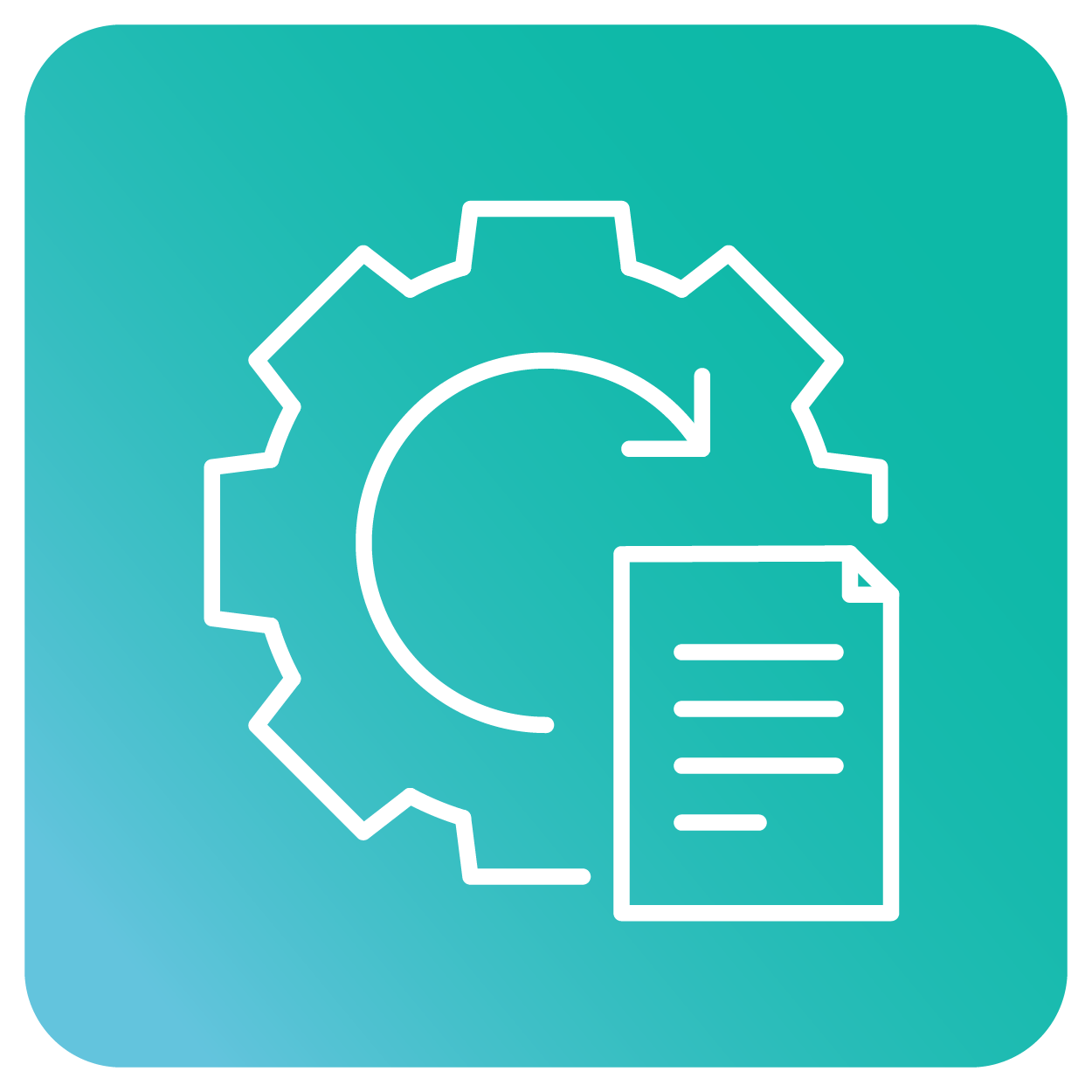
L&D really matters, but as a learning professional it’s also really easy to get bogged down in administrative tasks that pull focus from meaningful progress. Think scheduling courses, answering the same basic questions, and tracking who’s done what.
All this can eat up a huge chunk of your valuable time. That’s where AI can swoop in like a super-efficient admin assistant. Indeed, 80% of AI tool users report boosted productivity. That’s thanks to their ability to automate these time-consuming and repetitive tasks.
As a result, you’re freed up to focus on the more creative and strategic parts of your job — the stuff that makes a real difference.
4. Intelligent Analytics
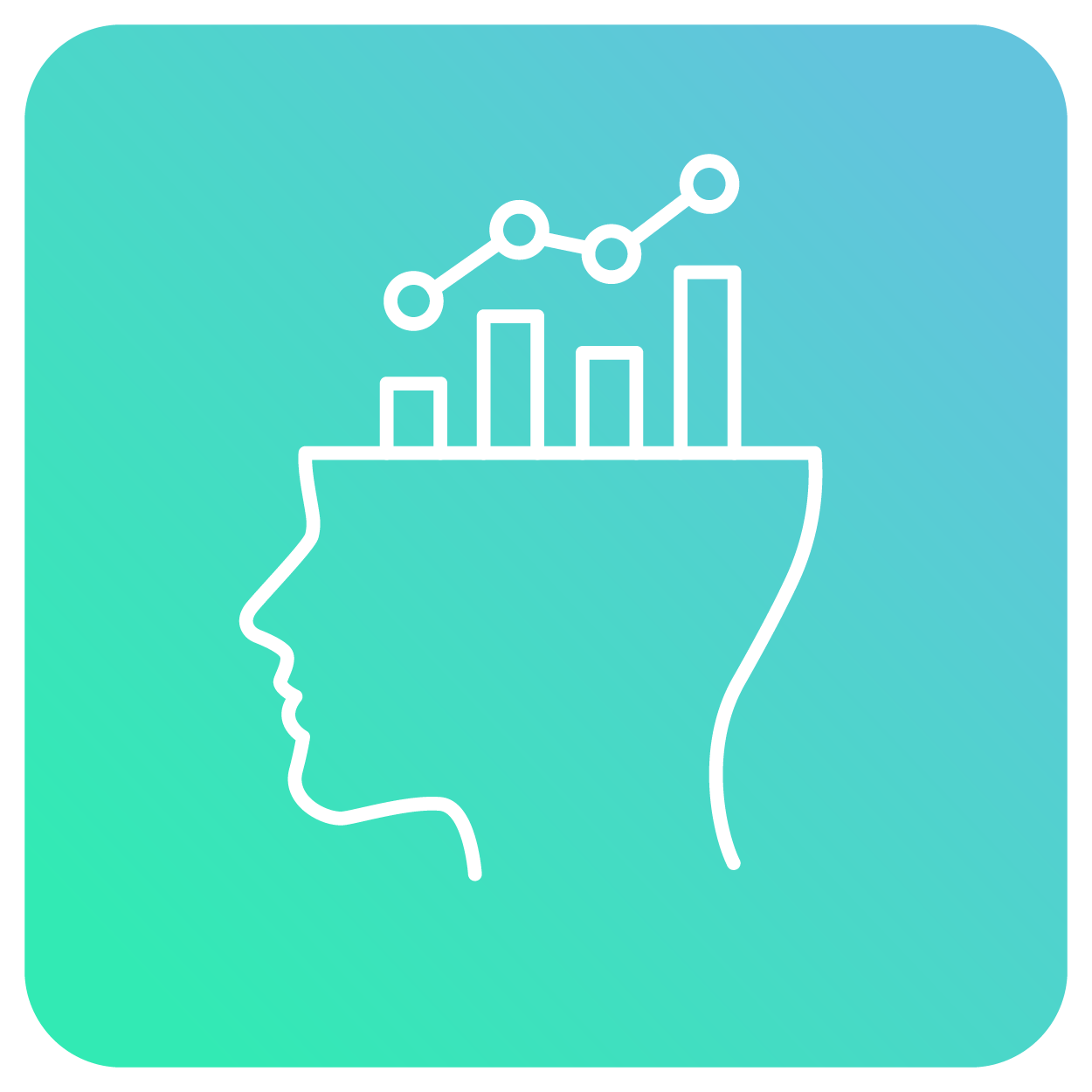
Knowledge is power and data is key. But sifting through it for real insights can be tough going. Thankfully, AI can provide support. Instead of surface level reports and training metrics, it can dig deep into your learning data to uncover hidden insights.
This means it can spot trends you’ve missed, predict who might be struggling, and show you what’s working and what’s not within your training. It’s like having your own super-smart data detective on your L&D team.
In fact, according to O’Reilly, almost half (48%) of organisations are already using AI-powered data analysis tools to optimise their operations. Don’t get left behind!
5. Gap Analysis

With skill gaps threatening to cost businesses $2.5 trillion over the next decade, L&D pros need to take action now. If you’ve ever wished you could instantly see your team’s skill strengths and weaknesses, then you’re in luck. AI can eliminate that guesswork.
Instead of relying on outdated performance reviews or baseless assumptions, AI can analyse all your data sources (think learning platform data, assessments, project outcomes, and so on) to pinpoint your skill gaps and even suggest plans to close them.
It’s also worth noting that AI itself is the cause of some of these gaps. In fact, 60% of employees expect AI to reshape their jobs, with 36% fearing replacement. Thankfully, you can empower your team to upskill or reskill for the future.
6. AI Coaches

Can you imagine having a personal mentor who’s available 24/7, doesn’t need coffee breaks, and is always ready to provide tailored guidance when needed? That’s the idea behind AI coaches in L&D.
While these technical marvels aren’t designed to replace human coaches entirely, they’re already supportive sidekicks. They’re capable of providing on-demand feedback, answering common questions, and helping learners to reflect on their journey.
This conversational learning approach can have real impact. Evidence shows that individual tutoring significantly boosts learning outcomes, with these students outperforming 98% of their peers in traditional classroom settings.
AI: The Learner’s Perspective
Of course, there’s another side to this AI coin, and it’s not quite so shiny. It’s important to remember that your learners are likely to leverage artificial intelligence as well, sometimes to bypass intended learning or to cheat the system.
Worryingly, more than half of employees (52%) confess to using AI to get through their mandatory work training. Browser-based tools like OpenAI’s Operator are only going to make this easier.
To deal with this, learning professionals need to stay vigilant, remain current on AI, and implement safeguards against misuse. Where possible, you should always emphasise the application of demonstrable skills, rather than simply regurgitating facts.
The Benefits of AI in L&D
As we’ve seen, AI can be wielded in a variety of different ways to produce a wide range of potential benefits for learning professionals and the learners they serve. Here’s a breakdown of some of the key advantages:
- Increased Efficiency: As shown, AI can automate administrative duties and streamline learning content creation, thereby lightening your load. McKinsey estimates that current GenAI technologies could automate between 60-70% of the working activities employees perform today.
- Enhanced Engagement: AI-powered personalisation can have a powerful impact on your learners. When content is relevant, feedback is timely, and support is tailored, your audience will stay motivated and focused. In fact, this metareview of adaptive learning found that it improves learner engagement in 39% of cases.
- Boosted Productivity: By automating repetitive tasks, streamlining workflows, and enhancing decision-making, AI also helps to boost our productivity. For example, this study found that using GenAI in business improves performance by an average of 66%.
- Better Outcomes: The above benefits also lead to improved business impact for you and your organisation. According to EY, 97% of senior business leaders who have invested in AI report a positive ROI. Specifically, 49% of firms report cost savings and an impressive 71% experience revenue bumps.
- Improved Accessibility: A strong 75% of researchers agree that AI will improve people’s access to learning. That’s because AI-powered tools offer features that promote inclusivity. Think text-to-speech, language translation, and even adaptive pacing.
Addressing AI Concerns & Challenges
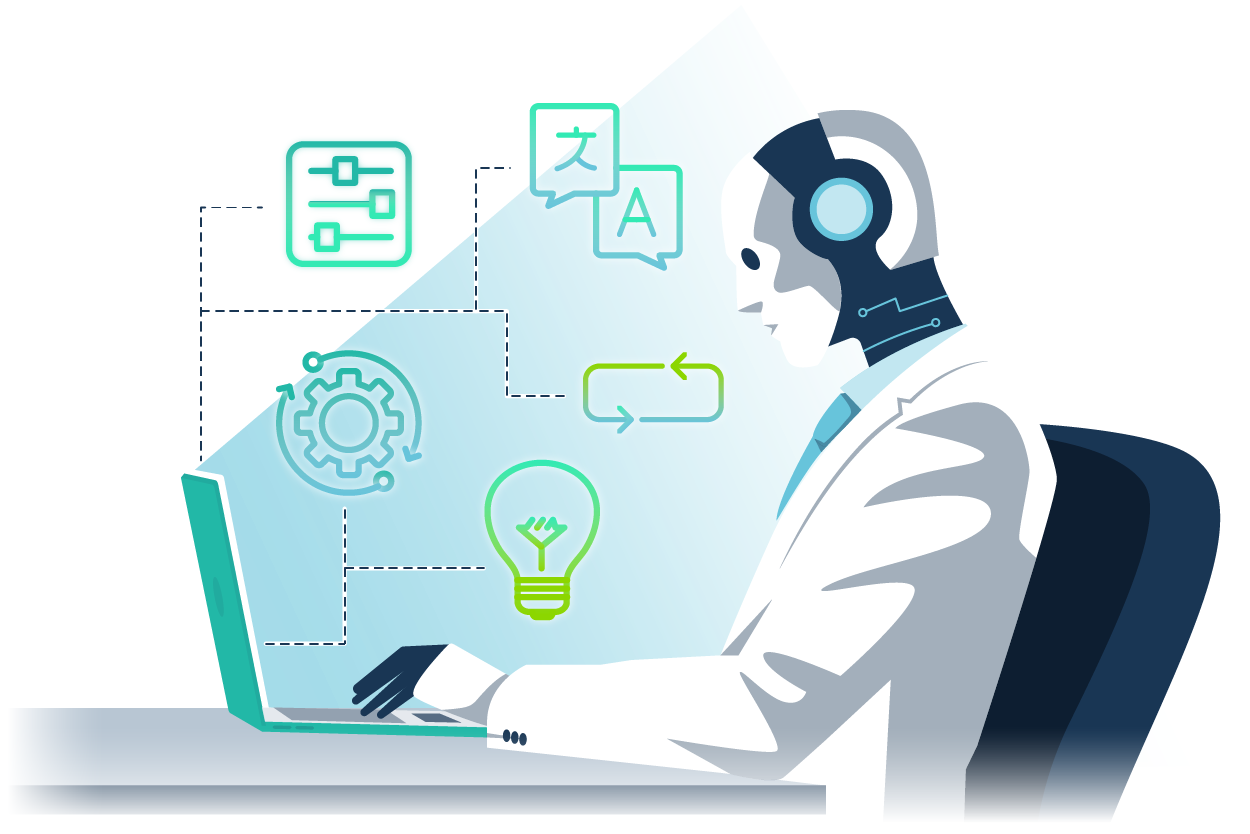
When it comes to AI, we all seem to have trust issues. However, the extent of this varies wildly from territory to territory. For instance, in India, 77% of adults say they trust AI technology, compared with just 32% in the United States.
These figures also change based on exposure and expertise. For example, 54% of scientists agree that AI will bring more benefits than risks, compared to just 13% of the general UK public. Perhaps we’ve all seen one Terminator movie too many?
Given the rapid evolution of AI, it’s natural to have questions and hesitations. With that in mind, let’s explore the main challenges that are eroding trust, and holding back L&D teams.
- Data Privacy: AI solutions are data-hungry, often requiring the collection and analysis of sensitive learner information (such as performance, behaviour, and personal details). Naturally, this raises concerns about how the data is stored and protected from unauthorised access. It’s telling that 63% of consumers express data privacy worries regarding AI.
- Algorithmic Bias: AI systems are only as good as the data they’re trained on. As the saying goes, ‘garbage in, garbage out’. If this data reflects existing societal biases (e.g. gender, racial, or socioeconomic), the AI will inevitably perpetuate them. Alarmingly, USC researchers have found bias in up to 38.6% of ‘facts’ used by AI.
- Implementation Costs: Another obvious issue is the financial burden of embracing AI. Unfortunately, all this cool tech doesn’t come for free. Indeed, 69% of business leaders are concerned about the cost implications of wider AI usage. A careful cost-benefit analysis will be crucial for your decision-making.
- L&D Upskilling: As with any new technology, AI has a learning curve. As things currently stand, L&D professionals may lack the skills and knowledge necessary to fully leverage these powerful AI tools. This need is reflected in the 59% of business leaders who plan to ramp up employee training on responsible AI use.
- No Human Touch: While embracing AI, we must be careful not to become overly reliant on it. This could diminish the important role of human L&D professionals, leading to less interaction and empathy in the learning process. This is especially concerning considering that 91% of L&D pros agree that ‘human skills’ (or soft skills) are increasingly important.
Clearly, AI in learning comes with some real challenges. Bypassing these issues requires being smart and ethical. That means keeping up with what AI can and can’t do, actively fighting bias in AI tools, and putting people first by making sure that learning still feels human.
Tips for Getting Started With AI
With a clear view of both AI’s benefits and challenges, you can now confidently assess your readiness. For those learning professionals who are eager to jump in and get started, we’ve gathered a range of practical tips to help guide your journey.
- Start Small: When adopting an exciting new technology like AI, it’s tempting to try to revolutionise everything all at once. However, the most effective approach is usually to begin with a focused pilot project. Start by identifying a specific L&D challenge that could benefit from AI. For instance, what time-consuming task could you automate?
- Find The Right Tech: Once you’ve identified your target challenge, carefully evaluate AI solutions that could address it. The market offers a growing range of options from specialised AI tools, to full-fledged AI-powered learning management systems (LMSs). Consider factors like cost, scalability, and reliability.
- Refine Your Prompts: If you’re embracing GenAI, then you’ll need to become an expert prompt crafter (or prompt engineer). This requires learning how to create clear and concise instructions for LLMs that help you to get the best possible response. Remember, the quality of your output is directly tied to the quality of your input.
- Data Quality: Given the significant risk of bias in training data, ensure the data your AI systems are trained on is accurate, relevant, and unbiased. While data cleaning and preprocessing are necessary, starting with a quality data source is often the most effective strategy.
- Focus on the Learner: Always remember that the goal is to use AI to augment and enhance human-led learning, not replace it. We’re not seeking to suck the fun out of professional development. As such, we should prioritise designing learning experiences that are both engaging and impactful.
- Stay Informed: The field of artificial intelligence is rapidly evolving, with new tools and techniques emerging on a practically daily basis. To get the most out of this technology, you’ll need to commit to keeping up with developments and continuously learning. We also recommend developing and updating clear ethical guidelines in line with market changes.
The Future of AI in L&D
Given the power and pervasiveness of today’s AI tools, it’s easy to feel like we’re already smack-bang in the middle of the future. But, the exciting news is that there’s still more to come. A lot more.
We anticipate that AI will soon enable increasingly granular personalisation of learning experiences (or ‘hyperpersonalisation’). This means real-time content adaption in line with specific needs, preferences, and circumstances.
In turn, content will be intelligently embedded into your employee’s workflows, with AI providing support and resources precisely when needed.
Finally, AI will soon move beyond descriptive reporting and embrace predictive analytics. Just imagine being able to identify upcoming skill needs, or forecasting the impact of your training on business outcomes. If that doesn’t get you excited, then we don’t know what will!
Final Words
The bottom line? AI is changing the L&D game and sitting on the bench is no longer an option. If we don’t make the most of this technology, we run the real risk of getting left behind. The future of learning is already unfolding.
Artificial intelligence opens up a treasure trove of possibilities. From curated learning paths that feel tailor made, to chatbots that answer questions in real-time, AI has the potential to make us smarter, faster, and more effective.
All we need to do is ensure that we integrate AI in a way that enhances, not diminishes, human connection and empathy within learning. This will allow AI to amplify our efforts, rather than dilute them. And isn’t that a vision worth pursuing?
Thanks for reading! If you’ve enjoyed this content, please connect with me here or find more articles here.
To thrive in the rapidly evolving world of L&D, you need to be ready for the AI-powered future. Download our ‘L&D Professional’s Handbook’ now for 160+ essential tips and strategies!



